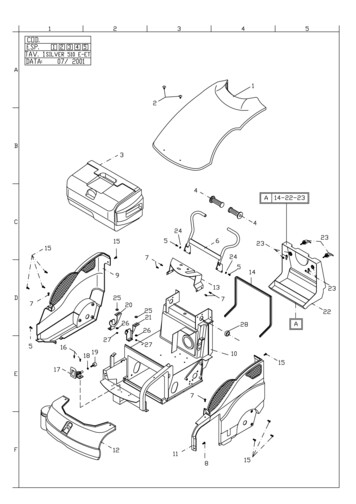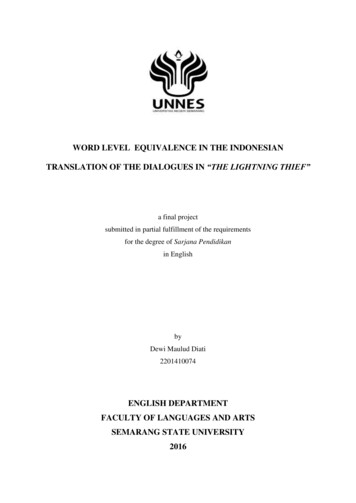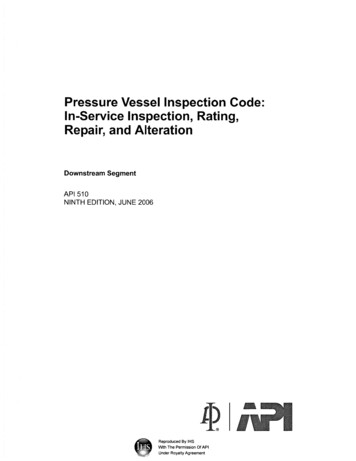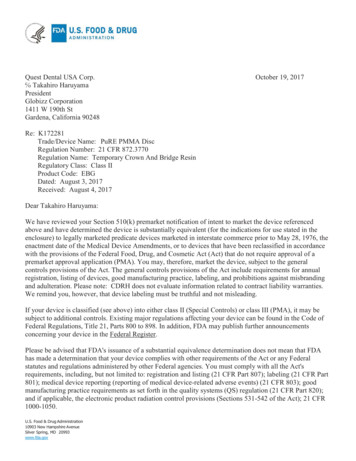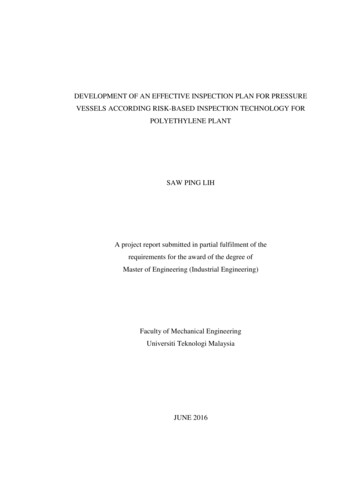
Transcription
510(k) SUBSTANTIAL EQUIVALENCE DETERMINATIONDECISION SUMMARYASSAY ONLY TEMPLATEA. 510(k) Number:K043224B. Purpose for Submission:The APTIMA Combo 2 (AC2) assay is a nucleic acid amplification test (NAAT)intended for the qualitative detection and differentiation of ribosomal RNA fromChlamydia trachomatis (CT) and/or Neisseria gonorrhoeae (GC) in endocervical,male urethral and vaginal swab specimens and in female and male urine specimens.The assay originally received FDA clearance on May 21, 2001 (K032554). Thecurrent application is for the additional indication of testing specimens collected andprocessed with the Cytyc ThinPrep 2000 System. An ancillary kit called the “GENPROBE APTIMA Specimen Transfer Kit” is included in the current submission tofacilitate specimen transport and processing.C. Measurand:Chlamydia trachomatis (CT) and/or Neisseria gonorrhoeae (GC) ribosomal RNAD. Type of Test:NAATE. Applicant:Gen-Probe IncorporatedF. Proprietary and Established Names:GEN-PROBE APTIMA Combo 2 AssayG. Regulatory Information:1. Regulation section:CT: 21 CFR 866.3120GC: 21 CFR 866.33901
2. Classification:CT: Class IGC: Class II3. Product code:CT: MKZGC: LSL4. Panel:Microbiology (83)H. Intended Use:1. Intended use(s):AC2 Assay package insert:The APTIMA Combo 2 Assay is a target amplification nucleic acid probe test thatutilizes target capture for the in vitro qualitative detection and differentiation ofribosomal RNA (rRNA) from Chlamydia trachomatis (CT) and/or Neisseriagonorrhoeae (GC) in clinician-collected endocervical, vaginal, and male urethralswab specimens, patient-collected vaginal swab specimens*, and female and maleurine specimens. The assay is also intended for use with testing of gynecologicalspecimens collected in the PreservCyt Solution and processed with the CytycThinPrep 2000 System. The assay may be used to test specimens fromsymptomatic and asymptomatic individuals to aid in the diagnosis of gonococcaland/or chlamydial urogenital disease.*Patient-collected vaginal swab specimens are an option for screening womenwhen a pelvic exam is not otherwise indicated. The vaginal swab specimencollection kit is not for home use.Ancillary Kit package insert:The GEN-PROBEâ APTIMAâ Specimen Transfer Kit is only for use with GENPROBE APTIMA assays for the detection of Chlamydia trachomatis and/orNeisseria gonorrhoeae. The GEN-PROBE APTIMA Specimen Transfer Kitallows for APTIMA Assay testing of gynecological specimens collected andprocessed by the Cytyc ThinPrep 200 Processor according to the instructionsprovided.2
2. Indication(s) for use:See intended use above3. Special conditions for use statement(s):This device is for prescription use only.4. Special instrument requirements:Gen-Probe Leader HC liminometer and Gen-Probe Target Capture SystemI. Device Description:The APTIMA Combo 2 (AC2) assay is a nucleic acid amplification test (NAAT).See Test Principle below for more details.J. Substantial Equivalence Information:1. Predicate device name(s):APTMA Combo 2 Assay2. Predicate 510(k) number(s):K0033953. Comparison with predicate:Same device as current submission, but with added PreservCyt (PC) specimenindication. Collection device and media are different, as are specimen handlingand storage instructions.K. Standard/Guidance Document Referenced (if applicable):Not ApplicableL. Test Principle:The GEN-PROBE APTIMA Combo 2 Assay combines the technologies of targetcapture, Transcription-Mediated Amplification (TMA), and Dual Kinetic Assay(DKA). During target capture, rRNA molecules are isolated from specimens bycapture oligomers on magnetic microparticles. After target capture, the specimensare ready for TMA. The GEN-PROBE APTIMA Combo 2 Assay reaction replicates aspecific region of the 23S rRNA from C. trachomatis and a specific region of the 16SrRNA from N. gonorrhoeae via DNA intermediates. Detection of the rRNA3
amplicons is achieved using single-stranded chemiluminescent DNA probes, whichare labeled with different acridinium ester molecules. The labeled DNA probescombine with amplicon to form stable RNA:DNA hybrids and light emitted from thelabeled RNA:DNA hybrids is reported as Relative Light Units (RLU). In DKA,differences in the kinetic profiles of the CT and GC probes allow for thedifferentiation of signal. The chemiluminescent detection reaction for CT signal hasthe “flasher” kinetic type. The chemiluminescent detection reaction for the GC signalhas the “glower” kinetic type. Assay results are determined by a cut-off based on thetotal RLU and the kinetic curve type.M. Performance Characteristics (if/when applicable):1. Analytical performance:a. Precision/Reproducibility:Precision testing was performed at three sites to obtain measures ofrepeatability and reproducibility. Reproducibility was established with a 12member panel generated by spiking PreservCyt Solution with 0 to 2000fg/assay of C. trachomatis and 0 to 5,000 fg/assay of N. gonorrhoeae rRNAand aliquotting 1mL into the APTIMA Specimen Transfer Kit collection tube.Two (2) operators at each of the three sites performed one run per day on eachof three days, totaling three valid runs per operator. Testing was performedusing one assay kit lot. The results of this precision study are summarizedbelow.Reproducibility when testing PreservCyt liquid Pap clinical specimenscontaining target organism has not been determined.4
b. Linearity/assay reportable range:Not Applicablec. Traceability, Stability, Expected values (controls, calibrators, or methods):Not Applicabled. Detection limit:A study was performed that showed the AC2 Assay detected CT cells at least4 fold below the analytical sensitivity claim (claim 1 IFU/assay) for 3replicates of each of 15 CT serovars tested in PC media. Likewise, 3replicates of each of 20 GC clinical isolates were detected in PC media at 10fold below the analytical sensitivity claim (claim 50 cells/assay).5
6
7
8
9
e. Analytical specificity:The Chlamydia and Neisseria species were used to evaluate the analyticalspecificity of the AC2 Assay. A total of 50 culture isolates were tested in theliquid Pap media. None of the 50 culture isolates produced a positive result inthe AC2 Assay. See results below:10
11
12
f. Assay cut-off:Not Applicable2. Comparison studies:a. Method comparison with predicate device:Not Applicable3. Clinical studies:A prospective multi-center clinical study was conducted to evaluate the use ofthe PreservCyt Solution (a component of the ThinPrep 2000 System) as analternative medium for gynecological specimens for the detection ofChlamydia trachomatis and Neisseria gonorrhoeae. One thousand six hundredforty-seven (1,647) symptomatic and asymptomatic female subjects attendingOB/GYN, family planning, public health, women's and STD clinics wereevaluated in the clinical study. Of the 1,647 evaluable subjects, 1,288 wereasymptomatic subjects and 359 were symptomatic subjects. Subjects wereenrolled from sites with CT prevalence that ranged from 3.2 to 14.0% and GCprevalence that ranged from 0 to 5.0%. Two specimens were collected fromeach eligible subject: one PreservCyt Solution specimen and one endocervicalswab. PreservCyt Solution specimens were processed in accordance with theThinPrep 2000 Processor Operator's Manual and APTIMA Specimen TransferKit Package Insert. After processing the PreservCyt Solution specimen withthe ThinPrep 2000 Processor, the specimen was transferred into the APTIMA13
Specimen Transfer Kit for testing with the APTIMA Combo 2 Assay. ThePreservCyt liquid Pap specimens and endocervical swab specimens weretested with the APTIMA Combo 2 Assay.Sensitivity and specificity for PreservCyt liquid Pap specimens werecalculated by comparing results to a patient infected status algorithm. In thealgorithm, the designation of a subject as being infected or non-infected withC. trachomatis or N.gonorrhoeae was based on endocervical swab specimenresults from two commercially-available NAATs. For C. trachomatis, thereference NAATs included the APTIMA Combo 2 Assay and the APTIMACT Assay. For N. gonorrhoeae, the reference NAATs included the APTIMACombo 2 Assay and the APTIMA GC Assay. Positive results from bothreference NAATs were required to establish an infected patient. A noninfected patient was established if the results from the two reference NAATsdisagreed or were negative.Sensitivity and specificity for C. trachomatis in PreservCyt liquid Papspecimens tested in the APTIMA Combo 2 Assay, by symptom status andoverall, is presented in Table 5c. For C. trachomatis, overall sensitivity was96.7% (87/90). In symptomatic and asymptomatic subjects, sensitivity was96.7% (29/30) and 96.7% (58/60), respectively. Overall specificity for C.trachomatis PreservCyt liquid Pap specimens was 99.2% (1545/1557). Insymptomatic and asymptomatic subjects, specificity was 98.5% (324/329) and99.4% (1221/1228), respectively. Table 6c shows the APTIMA Combo 2Assay sensitivity and specificity values for C. trachomatis in PreservCytliquid Pap specimens by clinical site and overall. For C. trachomatis, thesensitivity ranged from 92.9% to 100%. The specificity ranged from 97.7% to100%. Sensitivity and specificity for N. gonorrhoeae in PreservCyt liquid Papspecimens tested in the APTIMA Combo 2 Assay, by symptom status andoverall, is presented in Table 9c. For N. gonorrhoeae, overall sensitivity was92.3% (12/13). In symptomatic and asymptomatic subjects, sensitivity was100% (7/7) and 83.3% (5/6), respectively. Overall specificity for N.gonorrhoeae PreservCyt liquid Pap specimens was 99.8% (1630/1633). Insymptomatic and asymptomatic subjects, specificity was 100% (352/352) and99.8% (1278/1281), respectively. Table 10c shows the APTIMA Combo 2Assay sensitivity and specificity values for N. gonorrhoeae in PreservCytliquid Pap specimens by clinical site and overall. For N. gonorrhoeae, thesensitivity ranged from 80.0% to 100%. Specificity ranged from 99.0% to100%14
15
16
17
4. Clinical cut-off:Not Applicable5. Expected values/Reference range:The prevalence of C. trachomatis and/or N. gonorrhoeae disease in patientpopulations depends on risk factors such as age, gender, the presence of symptoms,the type of clinic, and the test method. A summary of the prevalence of C.trachomatis and N. gonorrhoeae as determined by the APTIMA Combo 2 Assayresults on PreservCyt liquid Pap specimens is shown below by clinical site andoverall.18
N. Proposed Labeling:The labeling is sufficient and it satisfies the requirements of 21 CFR Part 809.10.O. Conclusion:1. The submitted information in this premarket notification is complete and supportsa substantial equivalence decision.19
2 2. Classification: CT: Class I GC: Class II 3. Product code: CT: MKZ GC: LSL 4. Panel: Microbiology (83) H. Intended Use: 1. Intended use(s): AC2 Assay package insert: The APTIMA Combo 2 Assay is a target amplification nucleic acid probe test that utilizes target capture for the in vitro qualitative detection and differentiation of
